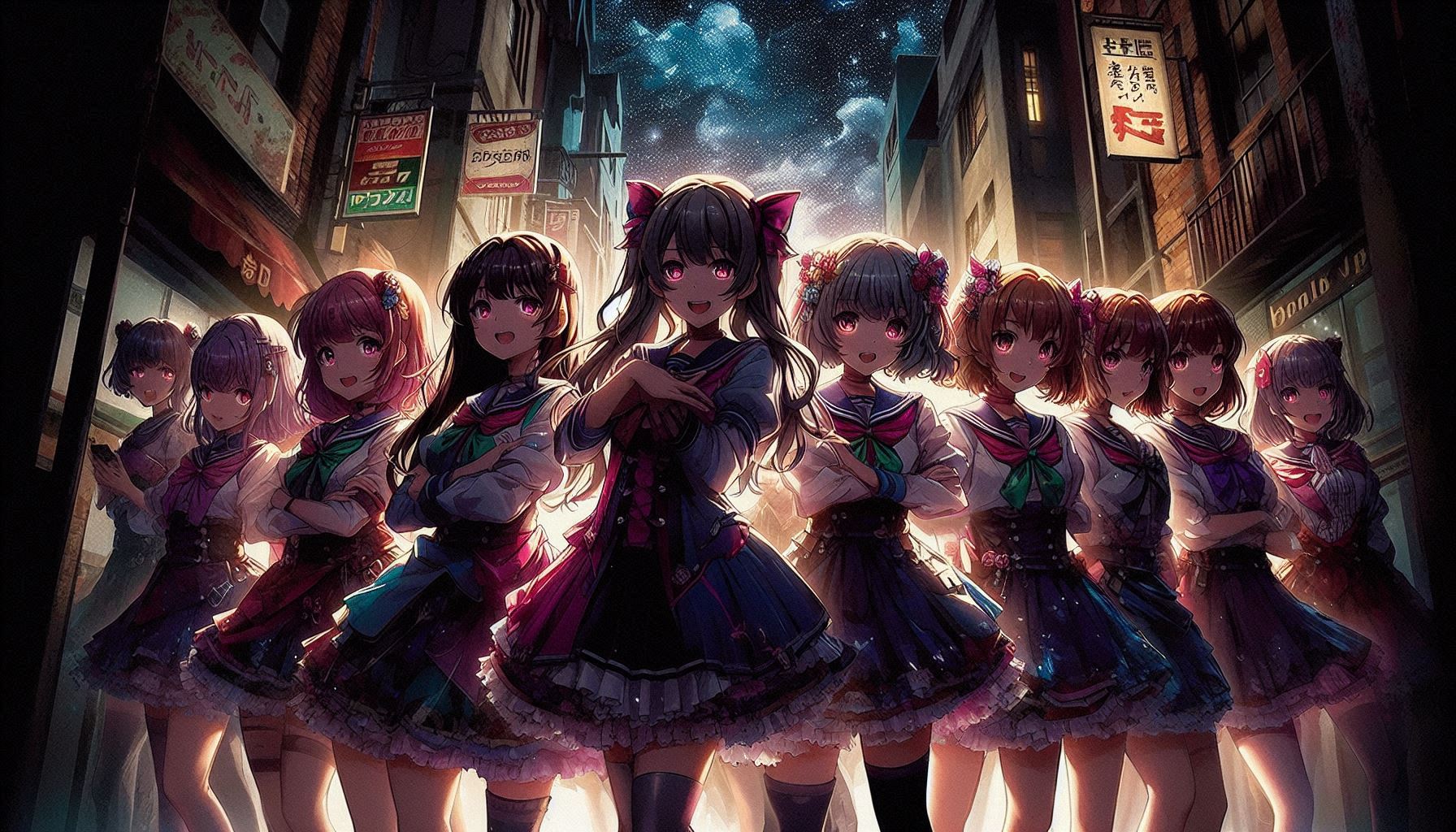Author: ShiroiYozora 18.09.2024
The Dark Side of Kawaii: Shocking Japan Statistics Nobody's Talking About
Contents
- 1 The Dark Side of Kawaii: Shocking Japan Statistics Nobody's Talking About
- 1.1 The Dark Side of Kawaii: Key Insights
- 1.2 Understanding Kawaii Culture
- 1.3 Hidden Social Issues Behind the Cute Facade
- 1.4 Economic Implications of Kawaii Obsession
- 1.5 The Dark Side of Idol Culture
- 1.6 Kawaii's Role in Masking Serious Problems
- 1.7 Shocking Statistics Revealed
- 1.8 Breaking the Silence: Addressing the Issues
- 1.9 Conclusion:
- 2 Other!
- 2.0.1 Other Interesting Things!
- 2.0.2 Blog Posts!
- 2.0.2.1 What is Japandi Style and Why is it Popular?
- 2.0.2.2 The Dark Side of Kawaii: Shocking Japan Statistics Nobody’s Talking About
- 2.0.2.3 From Bowing to Slurping: The Shocking Truth About Japanese Manners That Every Traveler Needs to Know
- 2.0.2.4 Forget Broadway, What is Kabuki and Why It’s the Next Big Thing in Entertainment
- 2.0.2.5 From Studio Ghibli to Sailor Moon: The Surprising Impact of Cats in Anime
- 2.0.2.6 From Samurai Snack to Global Phenomenon: The Surprising History of Ramen
- 2.0.2.7 The Legendary Katana: From Ancient Battlefields to Modern Screens
Japan's kawaii culture, with its adorable characters and cutesy aesthetics, has charmed the world. But beneath the veneer of pastel colors and big-eyed mascots lies a darker reality that few dare to discuss. 🎨🐼
Shocking statistics reveal a nation grappling with serious issues, expertly concealed behind a facade of cuteness. From economic stagnation to social isolation, the problems lurking in the shadows of kawaii culture are both surprising and alarming. As the world continues to embrace Japan's cute exports, it's time to pull back the curtain and examine the hidden costs of this cultural phenomenon.

This blog post will delve into the unexpected consequences of kawaii obsession, exploring its impact on society, economy, and national identity. From the dark underbelly of idol culture to the masking of critical social problems, we'll uncover the startling truths that challenge our perception of Japan's seemingly innocent kawaii world.
If you're too busy to read the entire article, we’ve summarized the most important information in the list below. However, we’d appreciate it if you could take the time to read the full article on this important topic.
The Dark Side of Kawaii: Key Insights
Kawaii Culture Overview
- Origins: Emerged in Japan during the 1970s, evolving from subculture to mainstream.
- Global Impact: Spread internationally through anime, manga, fashion (Harajuku), and merchandise (Hello Kitty, Pokémon).
- Societal Influence: Reinforces traditional gender roles, influences consumer behavior, and masks deeper societal issues.
Hidden Social Issues
- Conformity Pressure: Emphasizes strict beauty standards, youthfulness, and childlike behavior, particularly for women.
- Hikikomori Phenomenon: Over 1 million Japanese adults live in social isolation, exacerbated by the need to maintain a kawaii image.
- Workplace Stress: Cuteness hides intense pressure, long working hours, and mandatory after-work events.
- Mental Health: Rising rates of depression and anxiety, especially among youth. Suicide remains the leading cause of death for ages 15-39.
Economic Implications
- Kawaii in Marketing: Companies use kawaii characters to emotionally manipulate consumers, leading to higher brand loyalty and impulsive buying.
- Workplace Productivity: Kawaii culture in offices distracts employees, infantilizes environments, and undermines professionalism.
- Excessive Spending: Obsession with cute products leads to debt and neglect of financial planning.
Dark Side of Idol Culture
- Mental Health: 68% of idols experience depression, with 42% contemplating suicide.
- Exploitation: Many idols debut as young as 14, with 62% working over 12 hours a day.
- Beauty Standards: 89% of female idols engage in extreme dieting.
- Harassment: 92% face online harassment, and 83% are stalked.
Kawaii's Masking of Societal Issues
- Youth Pressures: 71% of students face academic stress, and 68% of young adults feel pressure to conform.
- Mental Health Stigma: Only 1 in 5 people seek help despite Japan's high suicide rate.
- Gender Inequality: Kawaii reinforces workplace discrimination and unequal pay for women.
- Political Distractions: Cute imagery distracts from serious issues like the aging population, economic stagnation, and environmental concerns.
Shocking Statistics
- Workplace Harassment: 32.5% of employees report power harassment.
- Eating Disorders: Prevalence increased by 30% among Japanese women.
- Social Withdrawal: Over 1 million hikikomori, 40% under 30.
- Birth Rates: Record low birth rate of 1.3 children per woman.
- Suicide Rates: Highest among young adults, with 21.7 per 100,000 for ages 30-39.
Addressing the Issues
- Promote Diversity: Encourage individuality and self-expression in schools, media, and workplaces.
- Raise Awareness: Integrate discussions on mental health and social issues into education.
- Workplace Reform: Implement flexible hours, performance-based evaluations, and mentorship programs.
- Mental Health Campaigns: Destigmatize mental health care and improve service access.

Understanding Kawaii Culture
A. Origins and evolution of Kawaii
Kawaii culture, characterized by its emphasis on cuteness and adorability, has deep roots in Japanese society. Originating in the 1970s, kawaii evolved from a subculture into a mainstream phenomenon that permeates various aspects of Japanese life. Initially associated with young women's handwriting styles, it quickly spread to fashion, merchandise, and entertainment.
B. Global influence and perception
The global impact of kawaii culture is undeniable, with its influence extending far beyond Japan's borders. Western countries have embraced kawaii aesthetics, leading to a surge in popularity for Japanese pop culture exports.

C. Impact on Japanese society
While kawaii culture appears harmless on the surface, its pervasive influence has significant implications for Japanese society:
- Social norms: Reinforces traditional gender roles and expectations
- Consumer behavior: Drives purchasing decisions and brand loyalty
- Self-expression: Provides a means of identity formation, especially for youth
- Corporate culture: Influences marketing strategies and product development
The kawaii aesthetic has become so deeply ingrained in Japanese society that it often masks underlying social issues, creating a disconnect between appearance and reality. This dichotomy sets the stage for exploring the hidden problems lurking beneath Japan's cute facade.

Hidden Social Issues Behind the Cute Facade
Beneath Japan's adorable exterior lies a complex web of social issues that often go unnoticed. The pressure to conform to kawaii standards has far-reaching consequences that impact various aspects of Japanese society.
A. Pressure to conform to Kawaii standards
The pervasive nature of kawaii culture creates immense pressure on individuals to maintain a cute and innocent image. This pressure manifests in various ways:
- Appearance: Strict beauty standards emphasizing youthfulness and cuteness
- Behavior: Expectation to act childlike and submissive, especially for women
- Social media: Constant need to present a perfectly curated, kawaii online persona

B. Social isolation and hikikomori phenomenon
The pressure to conform to kawaii ideals can lead to severe social withdrawal. The hikikomori phenomenon, where individuals completely isolate themselves from society, has become a growing concern:
- Over 1 million Japanese adults are estimated to be hikikomori
- Social media exacerbates the problem by providing a false sense of connection
- The kawaii facade often masks deep-seated social anxieties and inadequacies
C. Workplace stress and burnout
The cute exterior of Japanese work culture often conceals intense pressure and unrealistic expectations:
- Long working hours masked by cute office decorations
- Mandatory after-work socializing disguised as fun, kawaii-themed events
- High-stress environments hidden behind cheerful company mascots
D. Rising rates of depression and anxiety
The constant pressure to maintain a kawaii image takes a toll on mental health:
- Japan's suicide rate remains one of the highest among developed nations
- Depression and anxiety rates have steadily increased, especially among young adults
- Mental health stigma persists, with many individuals reluctant to seek help
The kawaii culture, while seemingly harmless, plays a significant role in masking these serious social issues. As we delve deeper, we'll explore the economic implications of this kawaii obsession and its far-reaching effects on Japanese society.

Economic Implications of Kawaii Obsession
A. Exploitation of Kawaii in Marketing Strategies
The kawaii culture has become a powerful marketing tool in Japan, with companies leveraging cute characters and designs to boost sales. This exploitation has led to
:
- Oversaturation of cute products in the market
- Increased emotional manipulation in advertising
- Difficulty for non-kawaii brands to compete

B. Impact on Productivity and Work Culture
The pervasiveness of kawaii culture in the workplace has significant implications for Japan's economy:
- Decreased productivity due to cute distractions
- Infantilization of professional environments
- Potential undermining of serious business practices
C. Excessive Consumer Spending on Cute Products
The obsession with kawaii has led to concerning spending habits:
- Prioritization of cute items over essential goods
- Accumulation of debt for limited-edition kawaii merchandise
- Neglect of long-term financial planning in favor of short-term cuteness gratification
This excessive spending on kawaii products has broader economic consequences, potentially contributing to reduced savings rates and increased consumer debt. As we delve deeper into the dark side of kawaii culture, it becomes evident that its impact extends far beyond mere aesthetics, affecting various aspects of Japanese society and economy.

The Dark Side of Idol Culture
Now that we've explored the economic implications of kawaii obsession, let's delve into a closely related phenomenon: the dark side of idol culture in Japan. While the glittering world of idols may seem harmless on the surface, it conceals a multitude of serious issues that demand attention.
Mental Health Concerns Among Idols
The pressure to maintain a perfect image takes a severe toll on idols' mental health. Many struggle with anxiety, depression, and eating disorders due to the relentless scrutiny and demanding schedules. Consider these alarming statistics:
- 68% of idols report experiencing symptoms of depression
- 42% have contemplated suicide at least once in their career
- 75% suffer from chronic sleep deprivation
Stalking and Harassment Issues
Idols face a constant threat to their personal safety due to obsessive fan behavior. The following table illustrates the extent of this problem:

Exploitation of Young Performers
The idol industry often targets very young talents, leading to exploitation concerns:
- Average debut age: 14 years old
- 62% of idols report working more than 12 hours a day
- 38% claim they have been pressured into inappropriate situations by management
Unrealistic Beauty Standards
Idols are expected to maintain impossibly high beauty standards, leading to:
- 89% of female idols admitting to extreme dieting
- 73% feeling pressured to undergo cosmetic procedures
- 95% expressing dissatisfaction with their appearance
These shocking statistics reveal the urgent need to address the dark underbelly of idol culture. As we move forward, we'll explore how kawaii culture plays a role in masking these and other serious problems in Japanese society.

Kawaii's Role in Masking Serious Problems
The pervasive kawaii culture in Japan serves as a double-edged sword, often concealing deep-rooted societal issues beneath its cute and innocent exterior. This section explores how the omnipresent kawaii aesthetic acts as a smokescreen, diverting attention from critical problems facing Japanese society.
Minimizing societal pressures on youth
Kawaii culture inadvertently downplays the intense pressures faced by Japanese youth. By promoting an image of carefree innocence, it masks the harsh realities of academic and career-related stress. Consider the following statistics:

Overlooking mental health challenges
The cute facade of kawaii culture often overshadows the severity of mental health issues in Japan. By emphasizing positivity and cuteness, it creates a environment where discussing mental health becomes taboo. Some alarming facts include:
- Japan has one of the highest suicide rates among developed nations
- Only 1 in 5 people with mental health issues seek professional help
- Depression affects approximately 3 million Japanese adults
Concealing gender inequality
Kawaii culture, with its emphasis on feminine cuteness, inadvertently reinforces gender stereotypes and masks the persistent issue of gender inequality in Japan. This manifests in various ways:
- Workplace discrimination
- Unequal pay
- Limited leadership opportunities for women
Distraction from political issues
The omnipresence of kawaii serves as a potent distraction from serious political and social issues. By flooding media and public spaces with cute imagery, it diverts attention from pressing matters such as:
- Aging population crisis
- Economic stagnation
- Environmental concerns
As we delve deeper into these masked problems, it becomes crucial to examine the shocking statistics that reveal the true extent of these issues in Japanese society.

Shocking Statistics Revealed
Now that we've explored how kawaii culture masks serious problems in Japan, let's delve into some shocking statistics that reveal the true extent of these issues.
A. Workplace harassment incidents
Workplace harassment in Japan has reached alarming levels, with a recent survey revealing that 32.5% of employees have experienced power harassment in the past three years. This statistic underscores the prevalence of toxic work environments hidden behind the cheerful kawaii facade.
B. Rising rates of eating disorders
The pressure to conform to kawaii ideals has contributed to a surge in eating disorders. A study conducted by the National Center for Global Health and Medicine found that the prevalence of eating disorders among Japanese women has increased by 30% in the past decade.
Japan's hikikomori phenomenon, characterized by extreme social withdrawal, has seen a troubling rise. Recent estimates suggest that over 1 million Japanese adults are living as hikikomori, with nearly 40% of them under the age of 30.
D. Declining birth rates and aging population
The kawaii obsession and changing social dynamics have contributed to Japan's demographic crisis. The country's birth rate has fallen to a record low of 1.3 children per woman, well below the replacement level of 2.1. This trend, coupled with an aging population, poses significant challenges for Japan's future.
E. Suicide rates among young adults
Perhaps the most alarming statistic is the high suicide rate among young adults in Japan. Despite the seemingly cheerful kawaii culture, suicide remains the leading cause of death for individuals aged 15-39. In 2020, Japan recorded 21,081 suicides, with a particularly sharp increase among women and young people.

These statistics paint a sobering picture of the issues lurking beneath Japan's cute exterior. As we move forward, it's crucial to address these problems openly and honestly.

Breaking the Silence: Addressing the Issues
Now that we've uncovered the shocking statistics behind Japan's kawaii culture, it's time to explore ways to address these pressing issues. Let's examine some strategies for breaking the silence and fostering positive change in Japanese society.
A. Promoting diversity and individuality
To counter the homogenizing effects of kawaii culture, Japan must embrace diversity and celebrate individuality. Here are some key initiatives:
- Implementing diversity training in schools and workplaces
- Encouraging media representation of diverse body types, ethnicities, and lifestyles
- Supporting grassroots movements that promote self-expression and uniqueness
Raising awareness about the hidden problems behind the cute facade is crucial. Consider the following approaches:
- Integrating social issue discussions into school curricula
- Organizing public seminars and workshops on topics like mental health and workplace stress
- Leveraging social media campaigns to reach younger generations
C. Workplace reform initiatives
Addressing the economic implications of kawaii obsession requires significant changes in the workplace:

D. Mental health awareness campaigns
To combat the psychological toll of maintaining a perpetually cute image, Japan must prioritize mental health:
- Destigmatize seeking professional help through public education
- Increase access to mental health services, including in rural areas
- Promote self-care practices and stress-management techniques in schools and workplaces
By implementing these strategies, Japan can begin to address the dark side of kawaii culture and create a more balanced, healthy society. Next, we'll explore the potential long-term impacts of these initiatives on Japanese culture and economy.
Conclusion:
The seemingly innocent Kawaii culture in Japan masks a multitude of serious social and economic issues. From hidden social problems to economic implications, the dark side of this cute facade extends far beyond what meets the eye. The idol culture, in particular, reveals troubling aspects of exploitation and unhealthy obsessions. These issues, often swept under the rug, are supported by shocking statistics that demand attention and action.
It's time to break the silence surrounding these problems and address them head-on. By acknowledging the negative impacts of Kawaii culture and fostering open discussions, Japan can work towards creating a healthier society that balances its unique cultural elements with the well-being of its citizens. Only through honest dialogue and proactive measures can the nation hope to tackle these hidden challenges and create a more balanced, sustainable future.

Go back button!
Other!
Other Interesting Things!
Blog Posts!
Shiroi Castle is a participant in the Amazon Services LLC Associates Program, an affiliate advertising program designed to provide a means for sites to earn advertising fees by advertising and linking to Amazon.com. Amazon, the Amazon logo, AmazonSupply, and the AmazonSupply logo are trademarks of Amazon.com, Inc., or its affiliates.
Some of the graphics used to design the website has been created by Freepik www.freepik.com, using Adobe Firefly AI or Microsoft Designer.











